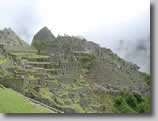Machu Picchu

Machu Picchu is one of the most impressive sights you will see on your visit to Peru and is located 70km Northwest of Cuzco the former capital of the Inca civilisation. Machu Picchu is 2,430 meters above sea level and is situated on a ridge in the Andean mountain region. It is often refered to as the "The lost City of the Incas" due to the fact that it was only discovered in 1911 by Hiram Bingham an American historian. It is believed that Machu Picchu was abandonedthround the time of 1532 which coincides with the Spanish conquest of the Inca empire. As Machu Picchu was not known to the Spanish conquistadores due to no mention of Machu Picchu in any of their records it adds to the mystery and intrigue surrounding the site. The fact that the Machu Picchu is a three hour trek into the Andean mountains and only a handful of farmers in the villages below knew of Machu Picchu it is no surprise it lay abandoned for centuries.
Machu Picchu is divided into two sections with an agricultural section that depicts where the natives grew their own crops that would have made the area completley self sufficient and the second area of Machu Picchu is the urban area. In the urban area you can find places of interest such as the temple of the sun and royal tombs were it is believed Hiram Bingham discovered the remains of Inca royalty. Other areas included in the urban section are the main square, temples, palaces, storehouses, workshops, stairways, cables and water fountains which run through both sectors, which measure 20 and 10 hectares respectively. The architecture involved in creating Machu Picchu is astonishing as itinvolves using dry-stone walls from a selection of stone blocks tightlylocked together without the use of any mortar to hold them together.

The purpose of Machu Picchu is still open for debate as no concrete evidence has been found as the Inca people did not record information on paper therefore the exact usage of Machu Picchu is open to debate. However there have been many reason put forward as to its purpose with one strong belief that the area was a retreat for Inca aristocracy which would explain the quality involved in the building and the fact that no peruvians knew of its whereabouts. Machu Picchu was declared an UNESCO World Heritage Site in 1983 and has also been included in as one of the new seven wonders of the modern world.

